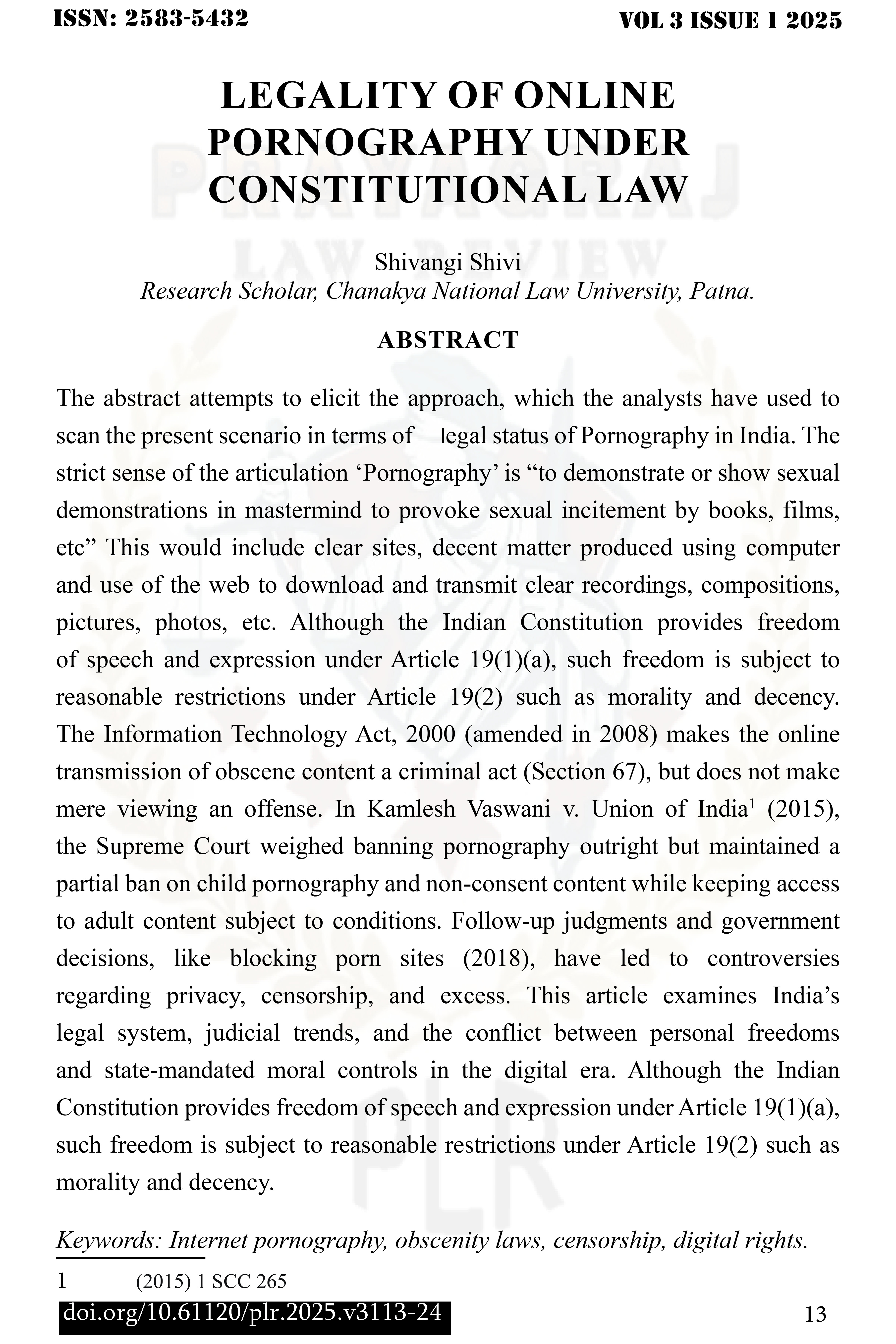Legality of online pornography under constitutional law
Keywords:
internet pornography, obscenity laws, censorship, digital rights, constitutional lawsAbstract
These abstract attempts to elicit the approach, which the analysts have used to scan the present scenario in terms of Legal Status of Pornography in India. The strict sense of the articulation 'Pornography' is "to demonstrate or show sexual demonstrations in mastermind to provoke sexual incitement by books, films, etc" This would include clear sites, decent matter produced using computer and use of the web to download and transmit clear recordings, compositions, pictures, photos, etc. Although the Indian Constitution provides freedom of speech and expression under Article 19(1)(a), such freedom is subject to reasonable restrictions under Article 19(2) such as morality and decency. The Information Technology Act, 2000 (amended in 2008) makes the online transmission of obscene content a criminal act (Section 67), but does not make mere viewing an offense. In Kamlesh Vaswani v. Union of India[1] (2015), the Supreme Court weighed banning pornography outright but maintained a partial ban on child pornography and non-consent content while keeping access to adult content subject to conditions. Follow-up judgments and government decisions, like blocking porn sites (2018), have led to controversies regarding privacy, censorship, and excess. This article examines India's legal system, judicial trends, and the conflict between personal freedoms and state-mandated moral controls in the digital era. Although the Indian Constitution provides freedom of speech and expression under Article 19(1)(a), such freedom is subject to reasonable restrictions under Article 19(2) such as morality and decency. The Information Technology Act, 2000 (amended in 2008) makes the online transmission of obscene content a criminal act (Section 67), but does not make mere viewing an offense. In Kamlesh Vaswani v. Union of India (2015), the Supreme Court weighed banning pornography outright but maintained a partial ban on child pornography and non-consent content while keeping access to adult content subject to conditions. Follow-up judgments and government decisions, like blocking porn sites (2018), have led to controversies regarding privacy, censorship, and excess. This article examines India's legal system, judicial trends, and the conflict between personal freedoms and state-mandated moral controls in the digital era.
References
(2015) 1 SCC 265
Oxford English Dictionary, "pornography, n." (3rd ed. 2021)
Cyber Law Introduction, CYBERLAWSINDIA, http://www.cyberlawsindia.net/index1.html.
Ranjit D. Udeshi v. State of Maharashtra, AIR [1965] SC 881
R v. Hicklin (1868) 3 QB 360
D. Cornell, “Feminism and Philosophy” (2000)
Vallishree Chandra and Gayathri Ramachandran, 'The Right to Pornography in India: An Analysis in Light Individual Liberty and Public Morality' (2011) 4 NUJS L Rev 323
John Stuart Mill, on “Liberty” (1975)
Govind v. State of M.P. (1975) 2 SCC 148
Naz Foundation v. Govt. of NCT (2009) 160 DLT 277
(2023) SCC Online SC 1234.
Manoj Mitta, Watching pornography no offence: IPC and IT Act, THE TIMES OF INDIA ,http://indianexpress.com/article/explained/background-and-legal-aspects-of-porn-block-on internet/.
IRWP Act 1986, Sec2(c): ‘indecent representation of women’ means the depiction in any manner of the figure of a woman, her form or body or any part thereof in such a way as to have the effect of being indecent, or derogatory to, or denigrating, women, or is likely to deprave, corrupt or injure the public morality or morals.
Manoj Mitta, Watching pornography no offence: IPC and IT Act, THE TIMES OF INDIA, http://indianexpress.com/article/explained/background-and-legal-aspects-of-porn-block-on-internet/.
(2015) 7 SCC 805

Downloads
Published
How to Cite
License
Copyright (c) 2025 Prayagraj Law Review

This work is licensed under a Creative Commons Attribution-NonCommercial-ShareAlike 4.0 International License.
All works published in PLR are licensed under Creative Commons Attribution- Non-commercial- ShareAlike 4.0 License.
Under these terms,
You are free to:
- Share — copy and redistribute the material in any medium or format
- Adapt — remix, transform, and build upon the material
- The licensor cannot revoke these freedoms as long as you follow the license terms.
Under the following terms:
-
Attribution — You must give appropriate credit, provide a link to the license, and indicate if changes were made. You may do so in any reasonable manner, but not in any way that suggests the licensor endorses you or your use.
-
NonCommercial — You may not use the material for commercial purposes.
-
ShareAlike — If you remix, transform, or build upon the material, you must distribute your contributions under the same license as the original.
- No additional restrictions — You may not apply legal terms or technological measures that legally restrict others from doing anything the license permits.











